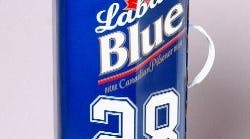General Mills used recycled, clay-coated news board for its "Shrek 2" cereal box. The character images can be ironed onto clothing.
|
Advanced paperboard packaging materials and structures are offering food processors an increasingly broad array of benefits, including superior microwave cooking results, on-the-go convenience and retail differentiation.In addition, improvements in recycled paperboard are making packaging constructed partially or entirely from recycled board more popular for frozen items and shelf-stable products such as crackers, chocolates and cereals.Food processors are among the biggest users of paperboard cartons. Data from the "Trends" report of the Paperboard Packaging Council (PPC) (
www.ppcnet.org), Alexandria, Va., show 60 percent of paperboard packaging is produced for food packaging. According to the report, the top paperboard end-use markets for food are beverages, dry foods and frozen foods. The fastest growing markets are retail carry-out, beverages and frozen foods.
Susceptor laminates heat upImprovements in microwaveable and dual-ovenable packaging — including susceptor technologies — are a key driver for the growing use of paperboard to package frozen foods. Susceptor materials include paperboard with embedded aluminum patterns as well as paperboard laminated to metallized polyester film. The susceptor absorbs microwave energy from the oven, and that energy is transferred to the food as heat. Susceptor packaging can provide microwave cooking benefits such as crisping, browning and elimination of hot and cold spots. It also delivers cooked-product textures similar to conventional cooking. For example, bread and bakery items microwaved in susceptor materials avoid problems common to microwaving in non-susceptor packaging, such as coming out chewy/tough or soggy/mushy.Susceptors also make it possible to microwave food products that include an uncooked protein component, such as fish. Raw Sea Foods Inc. (
www.rawseafoods.com), New Bedford, Mass., this year introduced its line of Cape Cod Cuisine entrees, meals and appetizers in susceptor trays. The frozen products, which include casseroles, are dual ovenable.Each of the meals and entrees provides two servings, and the emphasis is on quality. Because Cape Cod Cuisine has a premium positioning — retail pricing is $6.99 to $9.99 — a cook-in package that delivers excellent results in both conventional and microwave ovens was essential. Thanks to the susceptor pattern in the tray, the products "cook thoroughly, throughout the entire container," says Kane Kendall, marketing director for Raw Sea Foods. As an added benefit, the casserole dishes brown on top. Kendall says Raw Sea Foods considered using crystallized polyester (CPET) trays, but the trays melted in the conventional oven and became pliable in the microwave. And the CPET trays "did not heat nearly as evenly as the susceptor packages," he says. The edges of the dish would be hot and the center cold. Raw Sea Foods uses MicroRite Even Heating trays from Graphic Packaging International (GPI) Inc. (
www.graphicpkg.com), Marietta, Ga., to package Cape Cod Cuisine products. On the trays, an aluminum foil pattern is laminated to a paperboard substrate. "What I really liked about GPI's tray was that the product seemed to bake in the microwave rather than just heating," Kendall says. In addition, the susceptor tray holds its structure and is more durable than the CPET tray, he says. "It's been a great fit with what we are manufacturing."
Pizza rises, crisps in the microwaveSusceptor packaging is opening doors for packagers of bread and dough-based products, as well. "Susceptor film laminated onto paperboard enhances the crispiness of the food product when it is reheated in a microwave," says a spokesman for MeadWestvaco Packaging Resources Group (
www.meadwestvaco.com), Stamford, Conn."This is very popular in the hand-held food market," he adds. "With the trend of consumers eating on the run, food companies have developed hand-held pizzas, burritos, pies and other meal-size snack food that can be popped into the microwave and heated up in three minutes to produce a hot and tasty meal on the fly. The susceptor film laminated onto the paperboard substrate is the key factor for the development of this market segment within the food industry." Kraft Foods Inc. (
www.kraftfoods.com), Northfield, Ill., last year introduced its DiGiorno Microwave Rising Crust Pizza. And in May, the company added DiGiorno Microwave Thin Crispy Crust pizza to the product line. Available in standard pizza flavors, these frozen products provide two servings per package.For both, the packaging includes a modified atmosphere pouch, which the consumer removes before cooking. The pouch is tucked into a tray, which, when turned upside down, becomes a cooking platform for the product. The cooking surface is a paperboard/susceptor laminate.


